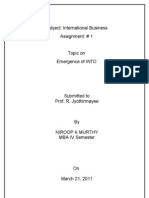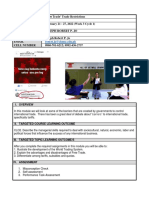Sample Questions
Sample Questions
Uploaded by
Akash BalgobinCopyright:
Available Formats
Sample Questions
Sample Questions
Uploaded by
Akash BalgobinOriginal Title
Copyright
Available Formats
Share this document
Did you find this document useful?
Is this content inappropriate?
Copyright:
Available Formats
Sample Questions
Sample Questions
Uploaded by
Akash BalgobinCopyright:
Available Formats
Question 1 Although the elegance and comprehensiveness of transactions costs reasoning has provided the internalisation approach with
a powerful logic (Rugman, 1981, 1985), it is still deficient in some respect as a general theory of the MNE given it focuses primarily on one mode of hierarchy i.e. the wholly owned subsidiaries. Yet, there a number of other modes which firms can and do adopt to deal with imperfections in international markets including licensing, management contracts, sub-contracting, joint ventures etc. Moreover, firms often employ different modes simultaneously in addressing the needs of a particular foreign market (Contractor, 1985; Davidson and McFetridge, 1985). Hence, the internalisation theory should also encapsulate an economic rationale for the other modes (Hennart, 1985) and specify the conditions under which each would provide efficiency gains over wholly owned subsidiaries and the market. Discuss. Section B Question 2 For nearly 50 years, member countries have sought to fulfil, first in the GATT and now in the WTO, the objectives reflected in the preamble to the WTO Agreement of conducting our trade relations with a view to raising standards of living worldwide. The rise in global trade facilitated by trade liberalization within the rules-based system has created more and better-paid jobs in many countries. The achievements of the WTO during its first two years bear witness to our desire to work together to make the most of the possibilities that the multilateral system provides to promote sustainable growth and development while contributing to a more stable and secure climate in international relations. Discuss
Question 3 The eclectic paradigm combines elements of quite different approaches to international production, and so it should not be misunderstood as itself another general theory: precisely because of its generality, the eclectic paradigm has only limited power to explain or predict particular kinds of international production; and even less the behaviour of individual enterprises,(Dunning, 1988a). Discuss Question 4 It should be obvious that simply the signing of a treaty to remove barriers to trade does not have any effect on the intra-group trade if the prospective partners do not demand each others exports. In this context, the only effect of regional integration would be indirect and related to the new level of protection of the group towards the outside world compared to the level of protection in each country prior to integration. Disregarding this effect and abstracting from intra-industry trade, in a two-good model, trade integration will have the usual trade creation/trade diversion effects when the prospective partners each have comparative advantage in the production and export of a different good while both goods are consumed by all countries. In other words, the difference in partners factor endowments makes them natural trading partners. Discuss. Question 5. Although it is one of the most important drivers of globalisation, it may nevertheless be argued that technology has widened the poverty gap. Developing and less developing countries inability to adopt new technologies entails that they are unable to compete against their developed countries counterparts. Discuss.
Question 6. It was argued that the WTO and GATT Uruguay Round Agreements have functioned principally to pry open markets for the benefit of transnational corporations at the expense of national and local economies; workers, farmers, indigenous peoples, women and other social groups; health and safety; the environment; and animal welfare. In addition, the WTO system, rules and procedures are undemocratic, un-transparent and non-accountable and have operated to marginalize the majority of the world's people. Discuss. Question 7. [We] are culturally all conditioned. We see the world in the way we have learned to see it. Only to a limited extent can we, in our thinking, step out of the boundaries imposed by our cultural conditioning, (Hofstede, 1995). What are the implications of this view for the study and practice of international management? Discuss Question 8 The benefits of trying to eliminate trade barriers in smaller groups of countries is facilitated through RTAs i.e. it can be easier to gain consensus among the relatively few members of a regional agreement as opposed to among all the member countries in the WTO. While RTAs are signed for a variety of reasons, the impact on trade, growth, and employment seems crucial in determining the extent to which broader objectives are achieved. It is difficult to identify arrangements that have advanced wider political objectives, without having first achieved progress in enhancing trade, and having this seen reflected in higher rates of sustainable growth and employment creation. Thus, it appears that the willingness to accept trade liberalization and
the accompanying economic adjustments is a first step that may be indicative of progress than can be made in other areas. Discuss.
Question 9 In the 1970s and 1980s, it became fashionable to search for general theories of international production which encompassed all the contributions of earlier writers thought to be significant. These were sometimes advanced as general theories of the multinational corporation, the main institutional agent of international production, or general theories of foreign direct investment, the major means by which international production is financed. When confronted with evidence on certain types of international production that their general theories did not seem to explain, the proponents of such theories all too frequently seemed to respond by either dismissing the relevance of the evidence or by adapting their terminology to accommodate it. To the extent they succeeded, their theories became increasingly cumbersome and less operational (Cantwell, 1988). Discuss. Question 10 The reality of global business today is that only few companies possess all of the competitive advantages which will enable them to compete successfully. As a result, firms are now seeking to complement their strengths through alliances/joint ventures with other firms. Discuss
Question 11
Although it is one of the most important drivers of globalisation, it can nevertheless be argued that technology has widened the poverty gap. Developing and less developing countries inability to adopt new technologies entails that they are unable to compete against their developed countries counterparts. Discuss.
Question 12 To the classical economists, trade was seen as an engine of growth as it facilitated the exploitation of comparative advantage. But, by the 1950's, it was obvious trade was not having the expected propulsive effects because of imperfections in international trading systems, such as oligopolistic competition, discriminatory pricing, product differentiation and high tariff barriers. As a result, many nations adopted an import-substitution strategy in a bid to reduce their import dependency. Discuss.
You might also like
- Lesson 1 - Trade in The Global Economy: Program OutcomesDocument15 pagesLesson 1 - Trade in The Global Economy: Program OutcomesDORENA ANIE LILINo ratings yet
- Some of The Key Reasons For The Emergence of WTODocument4 pagesSome of The Key Reasons For The Emergence of WTOShilpa ShreeNo ratings yet
- IER Assignment 1Document6 pagesIER Assignment 1biegatkuoth4No ratings yet
- New Generation University CollegeDocument6 pagesNew Generation University Collegebiegatkuoth4No ratings yet
- Is Free Trade Beneficial or Detrimental For Developing States?Document8 pagesIs Free Trade Beneficial or Detrimental For Developing States?alexpromoNo ratings yet
- Global Trade Liberalization Continues, But Risks Abound: Daniella Markheim and Ambassador Terry MillerDocument9 pagesGlobal Trade Liberalization Continues, But Risks Abound: Daniella Markheim and Ambassador Terry MillerAmmara QaziNo ratings yet
- Nirup AssignmentDocument6 pagesNirup AssignmentAshwin KaushikNo ratings yet
- WTO's Limited MissionDocument5 pagesWTO's Limited MissionJasmanpreet Singh JunejaNo ratings yet
- Wto MJDocument5 pagesWto MJJasmanpreet Singh JunejaNo ratings yet
- Preferential Trade AgreementsDocument16 pagesPreferential Trade AgreementsAdv Sailja Rohit DhootNo ratings yet
- GTA Policy BriefDocument8 pagesGTA Policy BriefUdit NarangNo ratings yet
- M09 Krug8283 08 SG C09Document10 pagesM09 Krug8283 08 SG C09Andrés ChacónNo ratings yet
- Model Answer: Course: MBA Semester: I Subject: International Business Environment and ManagementDocument7 pagesModel Answer: Course: MBA Semester: I Subject: International Business Environment and ManagementNabeelNo ratings yet
- MODULE 6 - 'Free Trade' Trade RestrictionsDocument9 pagesMODULE 6 - 'Free Trade' Trade RestrictionschingNo ratings yet
- WTO e Desenvolvimento Robert WadeDocument28 pagesWTO e Desenvolvimento Robert Wadegcostarebello1504No ratings yet
- Module 4Document47 pagesModule 4bitbknNo ratings yet
- What Is Globalisation: Globalisation - Its Benefits and DrawbacksDocument9 pagesWhat Is Globalisation: Globalisation - Its Benefits and Drawbacksbruhaspati1210No ratings yet
- Internationaltrade 11Document5 pagesInternationaltrade 11Bisrat MekonenNo ratings yet
- Gatt, WTO and GlobalizationDocument29 pagesGatt, WTO and GlobalizationGaurav NavaleNo ratings yet
- Literature Review of Wto and Developing CountriesDocument8 pagesLiterature Review of Wto and Developing CountriesafdtorpqkNo ratings yet
- NGO'S and Media: They Intervene As Proactive Players inDocument37 pagesNGO'S and Media: They Intervene As Proactive Players inMaria Jose SerranoNo ratings yet
- Delfin Ibt Report of International Trade Policy International Trade Law To Joint VentureDocument3 pagesDelfin Ibt Report of International Trade Policy International Trade Law To Joint VentureJohnlloyd RiveralNo ratings yet
- 1.6 Lesson 11 & 12 Contemporary WorldDocument11 pages1.6 Lesson 11 & 12 Contemporary WorldViernes, John Henilon C. - BSED FilipinoNo ratings yet
- Seattle and Beyond: A WTO Agenda For The New Millennium, Cato Trade Policy Analysis No. 8Document45 pagesSeattle and Beyond: A WTO Agenda For The New Millennium, Cato Trade Policy Analysis No. 8Cato InstituteNo ratings yet
- Pitrela Essay - Fresto - TriszkaDocument8 pagesPitrela Essay - Fresto - TriszkaTriszkaNo ratings yet
- Mita Paryani: International Business ProjectDocument12 pagesMita Paryani: International Business ProjectSunny AhujaNo ratings yet
- Using The Above ExplanationDocument6 pagesUsing The Above ExplanationNoor MughalNo ratings yet
- Environmental ImpactDocument5 pagesEnvironmental ImpactMhyr Pielago CambaNo ratings yet
- Wto and Devloping CountriesDocument24 pagesWto and Devloping Countrieskj201992No ratings yet
- Ques 1Document15 pagesQues 1Monisha ChaturvediNo ratings yet
- IB Project - HR - TYBBI - Roll No.44Document12 pagesIB Project - HR - TYBBI - Roll No.44Mita ParyaniNo ratings yet
- Order 1541405 - Should The System of International Trade Be Reformed To Enhance DevelopmentDocument9 pagesOrder 1541405 - Should The System of International Trade Be Reformed To Enhance DevelopmentLUWIZA RAMBOGONo ratings yet
- Role of WtoDocument7 pagesRole of Wtomuna1990No ratings yet
- PTA BuildingDocument4 pagesPTA BuildingAnne S. Yen100% (1)
- International Business Is A Term Used To Collectively Describe All Commercial TransactionsDocument24 pagesInternational Business Is A Term Used To Collectively Describe All Commercial TransactionsMohit MakkerNo ratings yet
- Final Reaction Paper 1 MFNDocument11 pagesFinal Reaction Paper 1 MFNFazilda NabeelNo ratings yet
- A More Balanced and Comprehensive Services AgreementDocument25 pagesA More Balanced and Comprehensive Services AgreementantonioNo ratings yet
- Literature Review of WtoDocument6 pagesLiterature Review of Wtoea442225100% (1)
- Krugman - What Should Trade Negotiators Negotiate AboutDocument9 pagesKrugman - What Should Trade Negotiators Negotiate AboutMihaelaNo ratings yet
- Gatt and WtoDocument2 pagesGatt and WtoSatya PanduNo ratings yet
- Issue Overview: Edward M. Graham and J. David RichardsonDocument42 pagesIssue Overview: Edward M. Graham and J. David RichardsonJeremy RevaNo ratings yet
- AmazonDocument7 pagesAmazonUmesh BachhavNo ratings yet
- WTO Report 1 PDFDocument2 pagesWTO Report 1 PDFKarlo BrennaNo ratings yet
- (International Trade Law Project On Inclusive Growth and Wto'Document18 pages(International Trade Law Project On Inclusive Growth and Wto'AnindotejiNo ratings yet
- Static and Dynamic Comparative Advantage MultiDocument8 pagesStatic and Dynamic Comparative Advantage MultiSusiraniNo ratings yet
- International Dimension of Global Competition Unit VIDocument6 pagesInternational Dimension of Global Competition Unit VIMohammad IrfanNo ratings yet
- Discuss Whether Regionalism (PTA) Is Helping or Hindering The Achievement of Global Free Trade. BuildingDocument3 pagesDiscuss Whether Regionalism (PTA) Is Helping or Hindering The Achievement of Global Free Trade. BuildingAnne S. YenNo ratings yet
- New Issues in World TradeDocument10 pagesNew Issues in World Tradesush_lukeNo ratings yet
- Stract:: TH STDocument6 pagesStract:: TH STSuketu JhaveriNo ratings yet
- Comilla University: Department of MarketingDocument17 pagesComilla University: Department of MarketingMurshid IqbalNo ratings yet
- Stages of Alliance Formation: Cooperation Collaboration Synergy Technology Transfer Economic SpecializationDocument9 pagesStages of Alliance Formation: Cooperation Collaboration Synergy Technology Transfer Economic Specializationnitinkumar1233No ratings yet
- The Changing Nature of International Business: Judith Piggott and Mark CookDocument10 pagesThe Changing Nature of International Business: Judith Piggott and Mark CookBruniscaNo ratings yet
- Function of WtoDocument12 pagesFunction of WtoSuman ChaudharyNo ratings yet
- International EconomicsDocument7 pagesInternational EconomicsJohn WarrenNo ratings yet
- ALE1 2024 Week9 ReadingDocument16 pagesALE1 2024 Week9 Readinglm2055506No ratings yet
- Law and Economics Final DraftDocument10 pagesLaw and Economics Final Draftmayankjuly04No ratings yet
- IR and Business Final Part 1-1Document14 pagesIR and Business Final Part 1-1Saneela MubarakNo ratings yet
- India: 153 Members On 23 July 2008 (1 January 1995Document4 pagesIndia: 153 Members On 23 July 2008 (1 January 1995BHANUDADWALNo ratings yet
- TCWDocument7 pagesTCWprincessmaysingcalaNo ratings yet
- Globalization Unveiled: Assessing the Impact of the World Trade OrganizationFrom EverandGlobalization Unveiled: Assessing the Impact of the World Trade OrganizationNo ratings yet
- COMMSLAB3 Activity Report 1Document8 pagesCOMMSLAB3 Activity Report 1Miguel VillarroelNo ratings yet
- CS Marvin RobeyDocument7 pagesCS Marvin RobeySandra HarrisNo ratings yet
- Java Codes 1 InvertDocument175 pagesJava Codes 1 InvertShaik Mahaboob BashaNo ratings yet
- Case Study On Bear StearnsDocument13 pagesCase Study On Bear StearnsBrayanJosueReyesHerreraNo ratings yet
- Musical InstrumentsDocument23 pagesMusical Instrumentssirius scottNo ratings yet
- Triptico InglesDocument2 pagesTriptico InglesPINEDA VELASCO DANNA KATHERINENo ratings yet
- Pusheen With Donut: Light Grey, Dark Grey, Brown, RoséDocument13 pagesPusheen With Donut: Light Grey, Dark Grey, Brown, RosémafaldasNo ratings yet
- PBFTSDocument4 pagesPBFTSTehsjNo ratings yet
- Jack and Jill SCENEDocument8 pagesJack and Jill SCENEChrisNo ratings yet
- II MOCK TEST Questions OnlyDocument46 pagesII MOCK TEST Questions OnlyazitaaaaaNo ratings yet
- Ishada Heat Stress PlanDocument13 pagesIshada Heat Stress Planhabib42833No ratings yet
- BME2 Formales 3TM2 Activity1Document3 pagesBME2 Formales 3TM2 Activity1Karylle FormalesNo ratings yet
- Graded Quiz Unit 6 PDFDocument12 pagesGraded Quiz Unit 6 PDFChantalCoudereNo ratings yet
- GHASNTDocument12 pagesGHASNTrhinemineNo ratings yet
- Elon Musk Form 4 Filings August 5 2022Document15 pagesElon Musk Form 4 Filings August 5 2022Maria MeranoNo ratings yet
- How Katie Bouman Accidentally Became The Face of The Black Hole ProjectDocument3 pagesHow Katie Bouman Accidentally Became The Face of The Black Hole ProjectjasnabokimilosevicNo ratings yet
- 7Z14Document7 pages7Z14André Frota PaivaNo ratings yet
- Effective Management of RiskDocument3 pagesEffective Management of RiskAbiNo ratings yet
- GST and Its ImpactDocument33 pagesGST and Its Impactbiplav2u100% (1)
- Gujarat Technological UniversityDocument4 pagesGujarat Technological Universityfeyayel988No ratings yet
- 1 Year Lab Python 2017 ManualDocument54 pages1 Year Lab Python 2017 ManualAnonymous pHX5EaANo ratings yet
- Readingpracticetest3 v9 2559205 PDFDocument13 pagesReadingpracticetest3 v9 2559205 PDFHendry WijayantiNo ratings yet
- ACC 2515A Engine Peak MeterDocument2 pagesACC 2515A Engine Peak Meter666667No ratings yet
- Chart - Classical CivilizationsDocument4 pagesChart - Classical CivilizationsYasmiin KidaneNo ratings yet
- Managing OA Payments: Experience From The Front Line (Chad Pillinger, University of Cambridge)Document14 pagesManaging OA Payments: Experience From The Front Line (Chad Pillinger, University of Cambridge)alisonhenningNo ratings yet
- Hand Lay-Up For FRP FabricationDocument26 pagesHand Lay-Up For FRP FabricationAbhey Dogra100% (3)
- Buyer Used Car Inspection ChecklistDocument2 pagesBuyer Used Car Inspection Checklistmohmadkilane69No ratings yet
- Correct Answer: B: - A. Ikev2 Ike - Sa - Init - D. Ikev2 Ike - AuthDocument12 pagesCorrect Answer: B: - A. Ikev2 Ike - Sa - Init - D. Ikev2 Ike - AuthmohamedNo ratings yet
- Owest Summary 2022Document21 pagesOwest Summary 2022mohamed kotbNo ratings yet
























































































